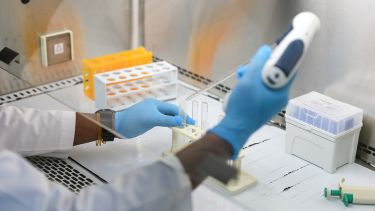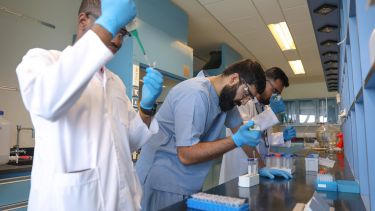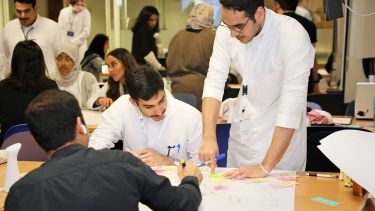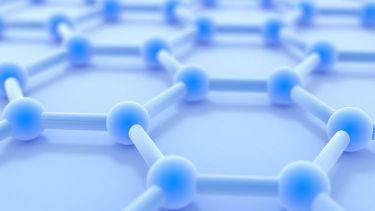
Researchers at Alfaisal University are exploring how nanotechnology and nanomaterials offer novel solutions to biomedical and energy concerns
Nanotechnology, which manipulates matter on a near-atomic scale to create new products, structures and materials, can help Saudi Arabia achieve its Vision 2030 and reduce its dependence on oil and diversify its economy. A single novel nanomaterial can have a range of applications from energy to healthcare, says Edreese Alsharaeh, professor of chemistry at Alfaisal University.
Alsharaeh heads the university’s nanomaterials and nanotechnology laboratory and is working with graphene to make nanocomposite materials for a variety of applications. Graphene is a single layer of carbon atoms, laid out like a blanket. It is the thinnest two-dimensional material in the world, and it has properties – such as its strength and ability to conduct electricity – that make it ideal to combine with other elements to make novel nanomaterials. “The two-dimensional material, graphene, has these exquisite material and chemical properties,” Alsharaeh says. “It has high electrical conductivity, high thermal stability and a high surface area.”
In his laboratory, researchers have combined graphene with the well-known antimicrobial element silver, but using less silver than traditional methods. Silver kills a wide range of bacteria and fungi, which is why it is often incorporated into wound dressings to stop infection. This topical method of averting infection could be an important ally in the fight against antimicrobial resistance.
Antimicrobial resistance occurs when pathogens evolve and become immune to the medicines we use to kill them. The World Health Organisation says this resistance, brought about by overuse of drugs such as antibiotics, is one of the top 10 global public health threats facing humanity. Alsharaeh and his team tested their antimicrobial silver graphene against most bacteria, including antibiotic resistant microbes, and found that, by combining silver with two-dimensional graphene, they were able to use only 5 per cent silver and achieve the same effect as using 100 per cent silver.
They also used their silver nanomaterial as a filler for bone cement. Doctors use bone cement to anchor artificial joints, such as those in the hip, knee, shoulder and elbow. “We found that [silver graphene] had the antimicrobial properties, as well as adding mechanical properties [when used in bone cement],” Alsharaeh says. “[The cement] makes it stronger and elastic, which is more comparable to real bone.”
The team, in collaboration with the university’s college of medicine and the King Faisal Specialist Hospital and Research Centre, has developed a prototype. They are currently having examples manufactured for use in human clinical trials. “After that, we’re going to go for commercialisation,” Alsharaeh says. The raw material is made by petrochemicals manufacturer SABIC, and “to the best of my knowledge, this is going to be the first product in bone cement that’s made here in Saudi Arabia”. He aims to manufacture the raw material in Saudi Arabia with a view to exporting it to other countries to use in their biomedical industries.
Alsharaeh’s nanomaterial research is not only helping the biomedical sector. He is also addressing one of the world’s most pressing issues: energy storage. In the face of climate change and rising temperatures, nations around the world, including Saudi Arabia, are looking to diversify their energy supply. Renewable energy is an important component of that global policy and is a focal area in Saudi Vision 2030, the country’s national strategy to guide its economic and social development. But for humanity to wean itself off fossil fuels, we need batteries that can store large quantities of energy without overheating or exploding. Alsharaeh and his team are working to develop lithium-sulfur batteries containing nanomaterials, which outperform existing lithium-ion batteries.
The university is also working with Saudi Aramco, the world’s largest oil exporter, to contribute to the global mission to achieve net zero emissions. The partnership aims to develop a rechargeable electrochemical energy storage solution for application in upstream subsurface and downhole high-temperature, high-pressure systems, to reduce the petroleum industry’s carbon footprint.
In hot countries, such as Saudi Arabia, it is difficult for batteries and technology to survive the heat. “A major problem with batteries is thermal runaway”, which can cause batteries to explode, Alsharaeh says. It’s important for all elements of the battery to work together so they can withstand high temperatures. Alsharaeh’s battery, which uses a nanocomposite made up of graphene, hexagonal boron nitride and a small amount of cobalt oxide, can withstand temperatures as high as 300ºC. It also offers better capacity than its lithium-ion competitors, something that is vital for the likes of electric vehicles, which need batteries to last so they can cover long distances.
Cobalt oxide is commonly used in batteries as it increases battery life and the capacity to store energy, but it is expensive. In fact, it is one of the most expensive materials in a battery, making up almost a third of the cost of an electric vehicle, according to BloombergNEF. In the same way that the researchers required less silver to achieve the same level of performance in their antimicrobial nanocomposite, so they have been able to use less cobalt in their batteries. They have patented the innovation and aim to continue developing it.
The battery prototype is slightly larger than a matchbox, as thick as cardboard, and flexible. Its size and flexibility make the battery a good candidate for wearable electronics, Alsharaeh says. “This is a hot topic in the nanotechnology world right now. This is the nice thing about two-dimensional materials: it’s flat, so you can roll it, you can bend it, you can build it up into any structure.”
What sets Alfaisal’s nanomaterials and nanotechnology laboratory apart from others is that it allows undergraduate students to take part in cutting-edge research. “There is not a lot of opportunity for undergrads to work on batteries around the world, because their [field] is usually dominated by industry,” he says. “They get to be part of the process [at Alfaisal].”
Ultimately, Alsharaeh’s goal is to set up a nanotechnology institute at Alfaisal University, which will act as a catalyst for nanomaterial research and product development in Saudi Arabia. “We want to develop novel materials for a variety of applications.” With an institute, “we can connect people”, including industry, stakeholders, researchers and students.
Find out more about the nanomaterials and nanotechnology laboratory at Alfaisal University.

























